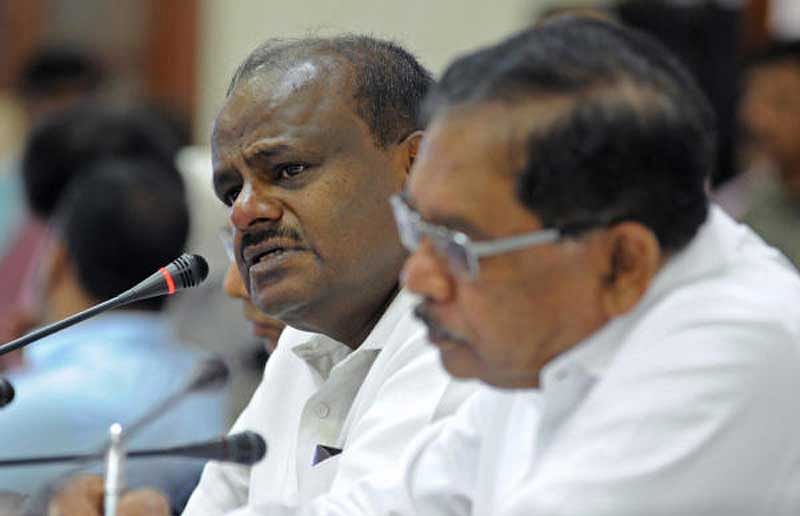
Confusion reigns supreme in Karnataka politics. It is difficult to hazard a guess about the stability of the Janata Dal (Secular)-Congress coalition government which came into being after the 2018 Assembly elections resulted in a hung assembly. JD(S) National President HD Deve Gowda’s recent statement about mid-term Assembly polls being imminent, which he retracted subsequently, has deepened the confusion.
The reasoning behind the coalition – fighting the Bharatiya Janata Party (BJP) unitedly in the Lok Sabha elections of 2019 – turned out to be a gross miscalculation. The coalition partners suffered their worst ever drubbing in the Lok Sabha elections winning just one seat each. As it happens in the aftermath of such defeats, the partners have ever since been blaming each other for the poor showing.
While this much suggests that it is time for them to break free of the pact, the political situation that has emerged at the national and the state level after the Lok Sabha elections has thrown both the Congress and the JD(S) into a classical ‘to-be or not-to-be’ dilemma. For the time being it seems that an uncertain future looming large before the coalition partners as well the Opposition BJP in the state has given a fresh lease of life to the 13-month-old government.
The defeat in the Lok Sabha elections has created a strange inevitability for both parties to continue in the coalition. For the Congress, although its rationale for the tie-up with the JD(S) does not exist any longer, having been reduced to insignificance at the national politics, its bosses in Delhi seem to be in no mood to forgo the only southern State where it has any share in power.
Similarly, for the JD(S), having lost the Lok Sabha elections badly even in its traditional strongholds, it makes much sense to continue in the Government, that too in an alliance with the Congress. It hopes to re-assert itself against the BJP, its new enemy, in the old Mysore region. However, retaining the coalition is going to be a Herculean task for both the partners as they are faced with serious intra-party and inter-party conflicts. At the same time, the BJP has been operating silently to poach its MLAs.
In the Congress camp, former chief minister Siddaramaiah, whose running feud with JD(S) Supremo Deve Gowda and Chief Minister Kumaraswamy is well-known, had only reluctantly agreed to the coalition. Now he sees the continuation of the alliance as being detrimental to the interests of the Congress. Another group in the Congress, of which a prominent member is Deputy Chief Minister G Parameshwar, seems to be favorably inclined towards the coalition. Although Siddaramaiah’s group also seems to have decided to go by the High Command’s wishes, repeated public statements against the government by prominent leaders including Siddaramaiah has lowered the public image of the government.
Both the chief minister and Deve Gowda have often used the media to hit back at Congress leaders, making the conflicts within the alliance a public spectacle. At the same time, a storm is brewing within the Congress against Siddaramaiah. A few MLAs who are disgruntled about not getting berths in the council of ministers hold his style of functioning responsible for the party’s debacle.
Meanwhile, the BJP has been trying its best to fish in troubled waters but its objective of luring MLAs of the ruling combine and making up the numbers for forming the Government is not going to be easy because of the complicated political arithmetic in the Legislative Assembly.
The BJP has 105 members and is still short of eight members for a simple majority in the 224-member Lower House. Getting these numbers by making coalition MLAs to cross-over to its side would attract the provisions of the anti-defection law. The only way left for the BJP, therefore, is to ensure that strength of the Assembly is reduced so that it can command a majority. For this the BJP needs to get at least 15 MLAs from the coalition to resign so that the strength of the Assembly is reduced to 209.
To lure so many MLAs to resign from either or both of the coalition partners is difficult despite the money power that the BJP is said to command. The saffron party has already burnt its fingers a couple of times in its attempt to trigger mass-resignations of coalition MLAs. Even if the BJP manages to get so many MLAs to resign, it will have to get all of them elected back as its members in the by-elections. This is a risky proposition. In the urban local body elections held days after the Lok Sabha elections in which the three parties fought separately the Congress did much better than the BJP.
Even if the current coalition breaks, an alternative government can be formed only if the JD(S) lends support to the BJP. While the JD(S) might not be averse to this, the fact that the former prime minister’s party can only be a minor partner in a possible coalition with the BJP is a disincentive for the JD(S) to exercise this option. The JD(S) may at best get the deputy chief minister’s post and a few key cabinet berths but its bargaining power with the BJP will be much lesser when compared to that with the Congress now. The JD(S) therefore is much better off with the existing arrangement with the Congress.
Deve Gowda’s recent statement about the imminent mid-term polls can also be seen as part of a strategy to save the government. Gowda knows well that MLAs in all the three parties are weary of fresh elections at this stage and that the threat of mid-term polls will make them think twice about lending support to any attempt to topple the government.
(A Narayana is an associate professor with Azim Premji University. He is a policy researcher and a political commentator)
The views expressed above are the author’s own. They do not necessarily reflect the views of DH.